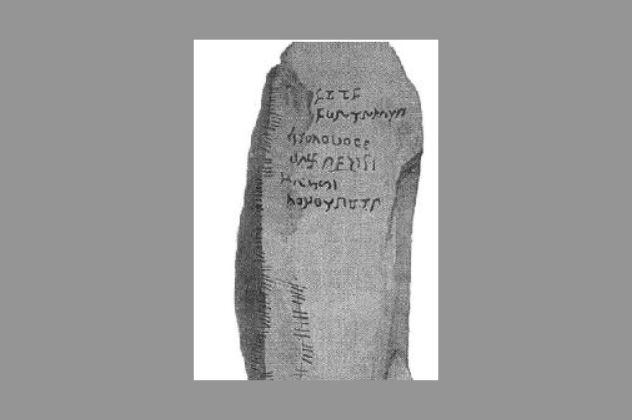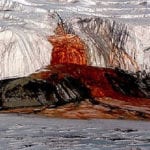 Miscellaneous
Miscellaneous  Miscellaneous
Miscellaneous  Animals
Animals 10 Strange Attempts to Smuggle Animals
 Travel
Travel 10 Natural Rock Formations That Will Make You Do a Double Take
 Movies and TV
Movies and TV 10 Actors Hidden in Your Favorite Movies
 Our World
Our World 10 Science Facts That Will Change How You Look at the World
 Pop Culture
Pop Culture 10 Incredible Female Comic Book Artists
 Crime
Crime 10 Terrifying Serial Killers from Centuries Ago
 Technology
Technology 10 Hilariously Over-Engineered Solutions to Simple Problems
 Miscellaneous
Miscellaneous 10 Ironic News Stories Straight out of an Alanis Morissette Song
 Politics
Politics 10 Lesser-Known Far-Right Groups of the 21st Century
 Miscellaneous
Miscellaneous 10 Undeniable Signs That People’s Views of Mushrooms Are Changing
 Animals
Animals 10 Strange Attempts to Smuggle Animals
 Travel
Travel 10 Natural Rock Formations That Will Make You Do a Double Take
Who's Behind Listverse?

Jamie Frater
Head Editor
Jamie founded Listverse due to an insatiable desire to share fascinating, obscure, and bizarre facts. He has been a guest speaker on numerous national radio and television stations and is a five time published author.
More About Us Movies and TV
Movies and TV 10 Actors Hidden in Your Favorite Movies
 Our World
Our World 10 Science Facts That Will Change How You Look at the World
 Pop Culture
Pop Culture 10 Incredible Female Comic Book Artists
 Crime
Crime 10 Terrifying Serial Killers from Centuries Ago
 Technology
Technology 10 Hilariously Over-Engineered Solutions to Simple Problems
 Miscellaneous
Miscellaneous 10 Ironic News Stories Straight out of an Alanis Morissette Song
 Politics
Politics 10 Lesser-Known Far-Right Groups of the 21st Century
10 Puzzling Unsolved Mysteries from Ancient History
The world is full of mystery. There is so much we don’t know about planet Earth and the life it contains. The bottoms of the deepest oceans, the depths of the thickest jungles, and the tip-tops of the tallest mountains all contain wonder unexplored.
Many of the explored parts of our great planet contain mysteries we haven’t yet unlocked, too. And that’s just the natural world. If you thought the earth was home to some strange and unexplainable things, just wait until you consider what ancient humans were up to on top of this massive planetary rock.
In this list, you’ll learn all about ten ancient man-made sites that have puzzled archaeologists forever. All the leading scientists and experts in the world haven’t been able to definitively answer why these places exist, how they were created, and what they were used for. Considering most of the mysteries on this list are thousands of years old, it’s probable we may never know the real stories behind their existence.
Did long-dead humans possess some technologies we can’t imagine? Did they build things inconceivable to what we think we know about the ancient world? Or are you thinking the same thing we are thinking right now: Was this all just done by aliens?
Related: 10 Amazing Archaeological Finds Discovered In Pompeii
9 The Stone Spheres (Costa Rica)
The official name for Costa Rica’s fascinating Stonehenge is the “Precolumbian Chiefdom Settlements with Stone Spheres of the Diquis,” according to UNESCO. That’s a mouthful, though, and “Stone Spheres” works well enough. In Spanish, many locals know the area as “Las Bolas.” Basically, Las Bolas makes up four different sites in a region of the Costa Rican rainforest called the Diquis Delta.
At those four sites, someone has placed a series of large, perfectly round stone orbs. Archaeologists believe the big, hard balls date back to a civilization that lived in the region between 500 BC and AD 1500. After years of hacking away at jungle overgrowth, researchers have uncovered about 300 of these stone spheres littered all across the ground.
The strangeness about them is twofold. For one, they are all virtually perfect spheres. Whatever technology these ancient Costa Ricans had allowed them to create amazingly round, spherical shapes from the hard stone. Archaeologists still aren’t sure how they were made so well.
And second, they are all different sizes. A few dozen of the smallest ones can fit in the palm of your hand, while a few dozen more of the largest weigh up to 15 tons (13.6 metric tons). For centuries, these stones had been buried under dirt and grown over by jungle plants. But in recent decades, they have started to become uncovered. And now, archaeologists are intent on protecting the site for future research.
Unfortunately, scientists and historians still don’t know what they were made for or why they are there. They believe the stones were placed in what would have been a residential area of the ancient settlement, but they don’t know why. The placement appears random, too. It doesn’t seem to correspond with the positioning of the sun, moon, or any other tip-off modern researchers can figure out.
Also, the long period over which they were made is extremely confusing to experts. Based on the layers of sediment that surrounded these stones, it appears the 300-ish spheres were created over a period of nearly 2,000 years. Whatever civilization was making these spheres was monumentally committed to the task. But why?[1]
9 The Miami Circle (Florida)
As you’ll see through the rest of this list, many of these unsolved ancient mysteries involve stones. There’s a reason for that: stone—unlike wood, mud, or anything else—withstands the tests of centuries of time. That we even know of these mysterious sites still in existence today is because their stone creations have been maintained through eras. The stone circle of Miami, Florida, is precisely one of those sites.
In 1998, South Beach developers broke ground on what was supposed to be a new condo complex. They wanted to demolish a few blocks of old housing and put up a line of sleek skyscrapers. As they were tearing down to build back up, they started digging deep down into the ground. And there, they found something fascinating: a circle of 24 large holes filled with heavy limestone tablets. By law, the developers called in archaeologists to uncover even more.
The experts began digging down even further (and much more carefully) and soon uncovered an entire setup. The stones were placed in a perfect circle that had a 38-foot (11.6-meter) diameter. The area was also covered in long-buried artifacts like animal bones, shark teeth, and even primitive ax heads made from basalt rocks. Archaeologists tried to carbon-date what they could with the sediment and ground surrounding the discovery. In doing so, they estimated the “Miami Circle” to be roughly 2,000 years old.
Beyond that, there isn’t very much known about the circle itself or why it was put there. Archeologists believe the stones were placed by a group of people known as the Tequesta. This mysterious tribe survived as late as the early 18th century, but they were a mystery to many even then.
In the 1500s, Spanish explorers came across them and described the Tequesta as bloodthirsty, hostile, and nomadic. Coming from the Spanish, of all people, those first two descriptors have a certain dark irony to them. But it’s the third one that puzzles archaeologists the most.
The Tequesta really were nomadic, living in small, constantly roving bands that hid out all across the Everglades. Not much is known of their existence, and even less is known of the Miami Circle. But the site still sits smack-dab in the middle of the city today, and researchers are still digging up finds and studying artifacts from it. Maybe one day, they hope, more will be unearthed (literally) about who the Tequesta were and what they were up to with that giant circle.[2]
8 The Strange Stone Statues (Indonesia)
Another day, another set of stones. This one is in Indonesia, though! The island of Sulawesi is home to tons of unique and dangerous wildlife. But it’s also home to a series of stone heads that no one has been able to wrap their human heads around. Just like in Costa Rica, the stones on Sulawesi are all different sizes. But these aren’t simple spheres—they include shapes of human figures.
Some are just a few inches tall, while others are more than 15 feet (4.6 meters) high. Still more are long and rectangular, making archaeologists wonder whether they could have been used as coffins. The coffin theory was put forth after explorers started finding heavy stone lids that fit some of them. In total, there are about 400 stone creations on Sulawesi, but the mystery of how they got there or why they were made remains.
Part of the strangeness of it all is that archaeologists haven’t been able to find any other signs of civilization around the stones. In the Costa Rican case we’ve already covered, researchers found signs of ancient roads and foundational blocks for what would have been homes and buildings.
But in Sulawesi, there’s none of that. It’s merely a bunch of stones and simply nothing else. Even after digging deep into the ground, scientists have yet to find tools, burial grounds, or anything else that would indicate a civilization once settled there.
Of course, because the structures are stone, scientists can’t carbon date them. And because they are weather worn but resilient, it’s impossible to tell when they could have been made. Local Indonesians have passed down stories throughout history suggesting they were placed there thousands of years ago by an ancient, long-lost tribe.
Some say the stones are the spirits of dead criminals from that era who have been cursed to remain on Earth for eternity. That’s all speculation, though. Archaeologists are no closer to understanding what the Sulawesi stones are or why they were created than when they first found them decades ago.[3]
7 The Sword in the Stone (Italy)
No, we’re not talking about Excalibur. The Italian mystery of their own sword in the stone is very much real—and very much mystifying! According to historians, Galgano Giudotti was a 12th-century nobleman who roamed the countryside of what is now known as Italy. Along the way, he maimed, killed, pillaged, and plundered along with many of his esteemed counterparts. But at some point, he became tired of bloodshed. He supposedly had a vision of the Archangel Michael, who told him to forgo fighting and find God.
Giudotti traveled to Montesiepi and supposedly had another vision. This one told him to drive his sword into a large stone there. The act would not only rob Galgano of his murderous weapon, but it would also supposedly prove the power of believing in the Lord. Not one to question these visions, Giudotti did just that. To his surprise, the sword slid right in. And it’s stayed there ever since. Locals even built a sacred chapel around the site!
Now, we know what you’re thinking: There’s no way this could possibly be true. Just like Excalibur, there must be some serious myth-making going on here, right? Well, maybe not. Modern archaeologists dragged out an X-ray machine to study the stone. They looked deep into the rock with ground-penetrating radar and discovered the sword is buried deep inside.
Amazingly, it’s not just a hilt placed upon the outside or a fake sword for show. It’s a real, true sword from the 12th century left inside this supposedly impenetrable stone. Now, the mystery: Archaeologists and historians have no clue how it could have gotten in there. Whatever visions Guidotti was seeing during his tribulations long ago were powerful enough to make us all look on in amazement and confusion eight centuries later.[4]
6 The Viking Penny (Maine)
In 1957, a wannabe amateur archaeologist hiking through rural New England found a small coin at what was thought to be an ancient Native American site. The location, at Naskeag Point in the state of Maine, was originally believed to be a sacred Indian setup. But when the amateur sleuth turned the silver coin into a group of experts, everything we thought we knew about the New World was flipped on its head.
After studying the coin in great detail, the experts realized it was an 11th-century Norwegian coin. It must have been carried over to North America by Viking sailors at some point in the 1000s or immediately after that. Immediately, it became one of the earliest examples of currency ever found in the Americas. And without question, it was the earliest known piece of Scandinavian silver that was found to be deposited on American shores.
By the mid-1970s, new teams of archaeologists had determined the coin dated back to a period between 1065 and 1080. That made sense, as the Native American site where it was found was itself thought to have been in use around 1100. But how did the coin get to North America? And how long were Norse travelers here to have handed it over as a gift or trade item to natives? The issue is further complicated because the so-called “Maine penny” is the only 11th-century Norse coin ever found in America.
With no other examples to speak of, scientists and skeptics alike wonder if it isn’t some kind of hoax. But it appears to have been altered in a way that may tell its true tale: A small mark on the silver coin indicates it was likely used as a pendant. Rather than functioning as currency, it could have been a one-off gift given by Norse visitors to new world natives. That would seem to make some sense—but archaeologists and historians simply don’t know for sure.[5]
5 Big Stone Circles (Jordan and Syria)
Another era, another location, another set of stones lined up in a circle. This time, the ancient mystery centers on Jordan and Syria. Aerial images taken from high above the desert plain for decades now have shown a large series of stone circles scattered across Jordan. There is one circle just over the border in Syria too. The rocks that make them up are not as smoothly cut as some others on this list. But they are laid out in truly massive circles across the flat land.
The smallest circle measures 720 feet (219.5 meters) in diameter, while the largest runs more than 1,450 feet (442 meters) across. They are all set to be between three and five feet (0.9-1.5 meters) in height. And the weirdest part is there are no openings for an entrance anywhere on any of them. So, if they were open pits, graves, or rudimentary stadiums of some sort, it’s not clear how they were set up. And with no gates or doors, they almost certainly weren’t used for livestock.
The craziest thing about these stone croppings is that they are laid out in virtually perfect circles. Modern-day GPS technology couldn’t have done much better of a job than what the ancient locals did with their creation. Archaeologists believe they date back sometime between 4500 BC and 2000 BC. That doesn’t help solve the mystery much, as we’re talking about a 2,500-year timeframe. Quite a bit went on as those two-plus millennia passed!
Researchers do think there were more stone circles built around the region, too, but some were destroyed as more recent towns and settlements cropped up. Now, these dozen archaeological sites are protected from further destruction. Scientists continue to study them but remain baffled at what might have been there long ago.[6]
4 The Newton Stone (Scotland)

There are plenty of standing stones all around Europe. The most famous of these is undoubtedly England’s Stonehenge, but other countries boast ancient monuments and mysterious artifacts too. In Scotland, the most bizarre and confusing of these is the Newton Stone.
Standing in Aberdeenshire, the Newton Stone was carefully carved into a serpent-like pattern. Along with whatever snake-type creature is shown, the stone appears to boast some flowers and some circles. Unfortunately, the meaning of those images isn’t known by archaeologists. However, the other side of the Newton Stone is where things get really crazy.
On the back, there are six lines of indecipherable text. There is a series of dash-like lines and carvings that historians are pretty sure date back to an ancient language called Ogham. However, there are a few other lines written in some other mysterious text. Linguists have no clue what the second language is or what the message is supposed to represent.
Some scholars believe it is a very rough, ancient version of Latin left over from when the Romans occupied the area. Others claim it’s a bastardized form of Ancient Greek, while another group of linguists wonders if there’s a Slavic background to the bizarre text. Still, other experts contend the text is Pictish—an ancient language spoken by peoples who lived ages ago in Scotland and northern England.
That last theory might make the most sense, but it hasn’t given modern researchers any conclusive answers. To this day, the Newton Stone’s purpose is not clear. And the message scrawled on its backside is even more of a mystery. Is it a religious shrine? Could it be a message having to do with weather patterns or other natural phenomena? Was the scribbled inscription a warning of a terrible future ahead? We simply don’t know, but the mystery of the site makes it a little creepy—and a lot of fun.[7]
3 The Plain of Jars (Laos)
Like many places on Earth, Laos is a land of mystique. The Southeast Asian nation’s capital city Vientiane is one of the most interesting and off-the-beaten-path urban centers in the modern world. But far away from the bustling capital is an ancient site shrouded in uncertainty. Yes, we’re talking about Laos’s famed Plain of Jars.
Trek about 100 miles (161 kilometers) north of Vientiane, and you’ll find it. Across hundreds of square miles out in an open wilderness plain, there are literally thousands of stone jars. They are spread out in a seemingly random order, and it doesn’t appear that there is any rhyme or reason to their placement.
Some are small, some sit in groups, and some rest alone on the ground. Some are huge, too, with the biggest ones weighing more than a ton and sitting up to 9 feet (2.8 meters) high. A bunch of them have stone lids sitting next to them or capping the jars themselves. But others don’t seem to have lids at all, simply sitting out in the sun alone. Many of them are decorated with very intricate carvings too. But many aren’t! The Plain of Jars has all kinds of different stone jugs and receptacles with no one attribute (well, besides their stone source) that unites them all.
So, what brought them about, anyway? And when did they get there? Those are both questions modern-day researchers are still trying to figure out. Some historians believe the jars are actually urns, and they represent a sacred burial site. Bodies would be placed in the jars, some experts claim, to allow them to decompose amid other ancient burial rites.
That could be possible, but it wouldn’t explain the tiniest jars. Others have a far lighter theory: The stone jugs were placed for the purpose of fermenting and brewing ancient rice wine. Now that’s a theory that tastes mighty good to us![8]
2 Judaculla Rock (North Carolina)
The Cherokee people who lived in the mountains of western North Carolina used to tell a tale of an ancient giant named Judaculla. As legend has it, he would jump from mountain to mountain and move across the rugged landscape with ease. When he needed to catch his balance mid-jump, he’d place his massive hands on boulders.
One of those boulders has supposedly been left with the imprints of his seven fingers. To this day, Cherokee locals call the strange, massive stone outcropping “Judaculla Rock,” They believe the giant’s huge digits left an eternal imprint upon it.
Whether there really was a giant or not, the “eternal” aspect of the fingerprints may not be so set in stone (pardon the pun). Old pictures of the rock from the 1930s seem to show the supposed seven fingers in much more noticeable contrast. In recent decades, the weather has dramatically taken its toll on the massive boulder. The soapstone-carved fingers—and a host of other Cherokee carvings from way back when—are slowly being stripped away by weather and the inevitable passage of time.
Archaeologists believe the whole thing dates back as long as 3,000 years ago, but beyond that, specifics are scarce. Interestingly, locals claim there are at least two other stones in the area that supposedly show Judaculla’s hand and fingerprints too. Those have never been located, though, so scientists wonder whether their alleged presence isn’t just one giant myth.[9]
1 The Skulls of Motala (Sweden)

If you’re sick of stone-related mysteries, we’re glad you stuck around for the very end. In Sweden, it’s not stone that has archaeologists questioning everything, but skull fragments. At a lakeside locale near the city of Motala, Sweden, researchers have been busy studying Stone Age setups of human skulls and other bone fragments.
At least 11 different skulls have been found at the site. Creepily, they are the remnants of adult men and women as well as children and babies. So right away, archaeologists wondered if some kind of ritual sacrifice or deeper religious meaning was involved with the skulls.
Dating the bones has proven to scientists that they all are about 8,000 years old. They were intermixed with ancient animal bones, too, further pushing the religious theory. But the skulls are so old that nobody can say for sure what they are there for or how they were used. At least two of the skulls had been pierced by wooden stakes. And one of the skulls actually contained broken skull bones from an entirely different ancient human. Creeped out yet?
In 2018, Swedish researchers announced that there were “healing injuries” on nearly all the skulls—both adult and children alike. “The majority of the skulls have traces of healing injuries in the same area on the head,” one researcher reported to Swedish media outlets. “It appears to be repetitive, and there are differences between the men’s and the women’s injuries.”
But what are these injuries there for? And why were the skulls arranged on stakes in such a strange manner? The 8,000-year-old mystery will likely linger on—perhaps for another eight millennia or more.[10]








